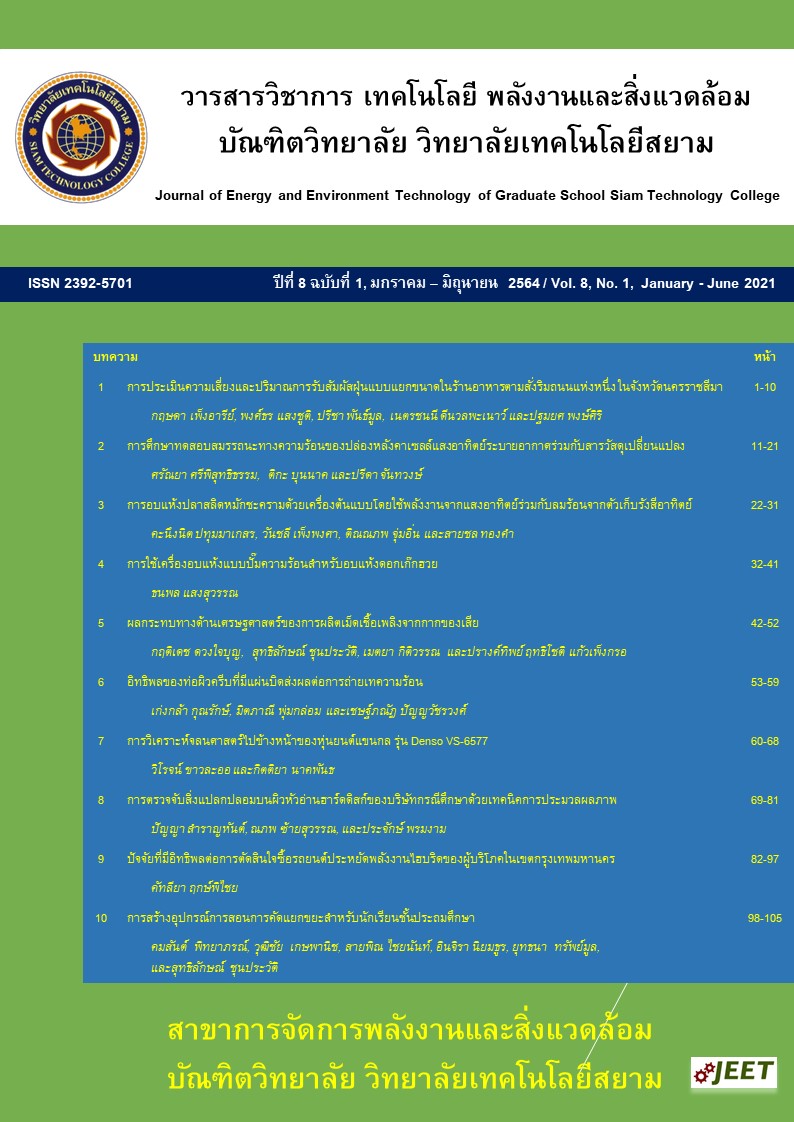ECONOMIC IMPACT OF FUEL PELLET PRODUCTION FROM THE SEWAGE SLUDGE
Main Article Content
Abstract
Fuel pellets produced from the sewage sludge of the canned tuna processing industry. Qualified to be used as a coal substitute for boilers. Due to the low production cost and the cost of sewage sludge removal for the canned tuna processing industry very well. However, the economic returns from the use of sewage sludge fuel pellets as a substitute for coal. They are somewhat susceptible to changes in coal prices as the main fuel of the boilers. Therefore, this study will focus on analyzing the economic return of fuel pellets produced from sewage sludge which varies according to changes in coal price. The results of the study showed that when the price of coal fuel tended to rise. Significantly higher economic returns from the use of sewage sludge fuel pellets. The results of the analysis showed that Total Saving Rate Cost (TSRC) would occur at the highest (69.10%), which would occur at + 20% of coal fuel, which resulted in the overall improvement of the economic index. As well as Net Present Value (NPV) 109,648.03 baht, Internal Rate of Return (IRR) 62.61%, Benefit per Cost Ratio (B/C) 201.29%, Payback Period (1.75 years). Whereas, when the price of coal fuel has dropped from -20% down, it is found that it is not worth the investment in producing fuel pellets from sewage sludge.
Article Details

This work is licensed under a Creative Commons Attribution-NonCommercial-NoDerivatives 4.0 International License.
เนื้อหาและข่อมูลในบทความที่ลงตีพิมพ์ในวารสารวิชาการ เทคโนโลยี พลังงาน และสิ่งแวดล้อม บัณฑิตวิทยาลัย วิทยาลัยเทคโนโลยีสยาม ถือเป็นข้อคิดเห็นและความรับผิดชอบของผู้เขียนบทความโดยตรง ซึ่งกองบรรณาธิการวารสารไม่จำเป็นต้องเห็นด้วย หรือว่าร่วมรับผิดชอบใด ๆ
บทความ ข้อมูล เนื้อหา รูปภาพ ฯลฯ ที่ได้รับการตีพิมพ์ในวารสารวิชาการ เทคโนโลยี พลังงาน และสิ่งแวดล้อม บัณฑิตวิทยาลัย วิทยาลัยเทคโนโลยีสยาม ถือเป็นลิขสิทธิ์ของวารสารวิชาการ เทคโนโลยี พลังงาน และสิ่งแวดล้อม บัณฑิตวิทยาลัย วิทยาลัยเทคโนโลยีสยาม หากบุคคล หรือหน่วยงานใดต้องการนำทั้งหมด หรือส่วนหนึ่งส่วนใดไปเผยแพร่ต่อ หรือเพื่อกระทำการใด ๆ จะต้องได้รับอนุญาต เป็นลายลักษณ์อักษรจากวารสารวิชาการ เทคโนโลยี พลังงาน และสิ่งแวดล้อม บัณฑิตวิทยาลัย วิทยาลัยเทคโนโลยีสยาม เท่านั้น
References
สำนักเทคโนโลยีสิ่งแวดล้อมโรงงาน. หลักปฏิบัติเพื่อการป้องกันมลพิษ (เทคโนโลยีการผลิตที่สะอาด) สำหรับอุตสาหกรรมรายสาขาปลากระป๋อง. กรุงเทพมหานคร; 2546
World Bank. Environmental Guidelines. Washington D.C. USA: World Bank Publishing; 1984.
กรมโรงงานอุตสาหกรรม. คู่มือการจัดการสิ่งแวดล้อมอุตสาหกรรม. กรุงเทพมหานคร; 2542
United Nations Environment Programme (UNEP). Cleaner Production Assessment in Fish Processing. USA: Nairobi Publishing; 2000
กรมอุตสาหกรรมพื้นฐานและการเหมืองแร่. คู่มือบัญชีของเสียที่เป็นแหล่งทรัพยากรทดแทน (กลุ่มยานยนต์และชิ้นส่วนยานยนต์). กรุงเทพมหานคร; 2556
กฤติเดช ดวงใจบุญ. “การผลิตเม็ดเชื้อเพลิงจากกากตะกอนน้ำเสียของอุตสาหกรรมปลาทูน่ากระป๋อง”. วารสารวิชาการเทคโนโลยีพลังงานและสิ่งแวดล้อม วิทยาลัยเทคโนโลยีสยาม, 2563; ปีที่ 7 ฉบับที่ 2: 25-39.
World Bank. International Coal Report . Bloomberg: McCloskey Coal Report; World Bank. Publishing; 2021


